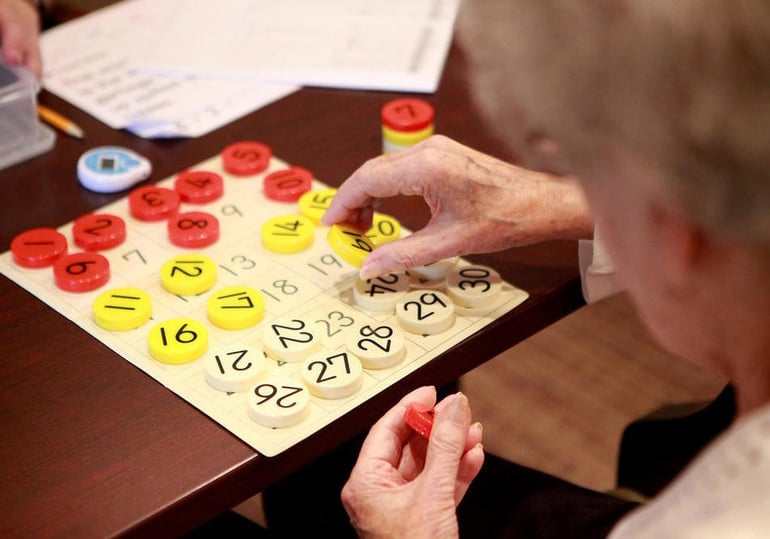
More than a decade ago, Episcopal Retirement Services (ERS) and Marjorie P. Lee (MPL) were one of the nation's first aging-services organizations licensed to implement SAIDO Learning®, part of the suite of Living Well Memory Support therapies for those living in memory care households.
“Studies have shown that doing simple reading and math will increase the function of the brain. Although it is not a cure, we have seen residents who have improved in their capacities after doing SAIDO for an extended period,” said Emerson Stambaugh, ERS executive director of hospitality services.
Emerson, Anthony Williams (Health Services Administrator), and Debbie MacLean (Life Enrichment Director) led a dedicated team to relaunch the SAIDO program MPL. In the SAIDO program, residents, known as Learners, are paired with staff members, called Supporters, in small groups of one or two.
Within weeks of the non-pharmacological therapy's relaunch, the team noticed improvements in the learners’ daily routines. SAIDO has been shown to improve the symptoms of cognitive loss among older adults with dementia, including increased social engagement, elevated confidence, enhanced memory, and gains in writing and speaking abilities.
“I’ve seen residents who were pretty silent become more confident and more vocal, and I have even had residents correct mistakes that I’ve made as a supporter,” Emerson said.
Numerous residents have told ERS team members they feel a positive difference from their SAIDO participation.
SAIDO: Innovative Approach
In 2013, ERS and MPL were selected and trained to implement SAIDO, an innovative program that helps bring hope to those living with dementia.
Emerson has participated in the program since its beginning. As a lead supporter, he trains new team members in SAIDO before working with residents.
The program has also been relaunched at Deupree Cottages, also owned and operated by ERS.
Effective memory care is exceptionally challenging to provide. Given that Alzheimer’s disease is the sixth leading cause of death in the United States, with over 7 million people living with dementia, there is a pressing need to find better treatments. SAIDO represents one of the most promising memory-care methods implemented to date.
Exercise for the Brain
Maintaining physical fitness is vital as people age, but SAIDO helps people exercise their brains with a learning intervention that improves social interaction.
Many providers have focused on the decline when caring for older adults with dementia and managing their symptoms. SAIDO is an opportunity to complement existing therapies and focus on enhancing resident engagement.
Dementia is difficult to treat, though research is ongoing. There is currently no “cure” for dementia. Because different diseases cause dementia, it is unlikely to be a single cure. Research is aimed at finding treatments for dementia-causing diseases, such as Alzheimer’s disease.
What is SAIDO Learning®?
SAIDO was created by Kumon Institute researchers and Professor Ryuta Kawashima of the Smart Aging International Research Center (SAIRC) at Tohoku University.
SAIDO means "again" in Japanese.
In the SAIDO system, a caregiver “Supporter” works with two older adults “Learners” by engaging them in a series of precise, simple brain exercises. Some of the exercises are arithmetic-based, others are reading and writing exercises.
The exercises the Supporter provides are designed to stimulate the prefrontal cortex, the area associated with decision-making, complex cognitive planning, personality expression, and social behavior moderation. Many researchers believe that dysfunction in the prefrontal cortex causes dementia-type disorders.
Learning sessions last 30 minutes and are conducted five times per week. According to SAIDO’s developers, “The object of the therapy is not to teach the material but to engage the Learner in the accomplishment of repeated successful exercises, progressing to new material at the Learner’s level and pace.”
As Learners proceed through the program, they develop more confidence. They tend to show improvements in performance on standard cognitive function tests like the Mini-Mental State Examination (MMSE) and the Frontal Assessment Battery at Bedside (FAB).
SAIDO has been practiced for over 18 years in 1,600-plus care centers across Japan, increasing engagement in over 18,000 older adults. Now, ERS has relaunched the effective SAIDO® Learning system for its residents.
Related Blog: What are the Three Stages of Dementia?
Enriching Team Member and Resident Relationships
Team members are trained to support residents during SAIDO sessions, and consistent interactions tend to deepen these relationships. In addition to their therapeutic value, these interactions advance the ERS mission to be of service to one another.
The sessions consist of one team member and two residents. It’s beneficial to have two learners because they support one another and give each other some friendly competition. The dedicated time spent together strengthens relationships between residents and team members.
SAIDO helps promote deep, meaningful relationships while providing the residents with a greater sense of self. The exercise can restore some of the confidence that the disease has taken away from them.
“SAIDO allows us to get to know the residents better, and it lets residents spend time with people they might not see regularly,” said Emerson.
Finally, SAIDO also provides residents with a positive environment in which to find success.
“Residents with memory loss are sometimes told things they can’t do. But our culture with SAIDO is that we want to celebrate their good work and efforts. If they are given a piece of art to paint, there is no judging their ability to make a copy of what they see. We are celebrating their version of it,” Emerson said.
SAIDO helps promote deep, meaningful relationships while providing residents with a greater sense of self. The exercise can restore some confidence that the disease has taken away from them.
Interested in exploring memory care options? Complete our free (and quick) 4–5-minute survey to learn more about which living options may be the best fit for you and your family.












